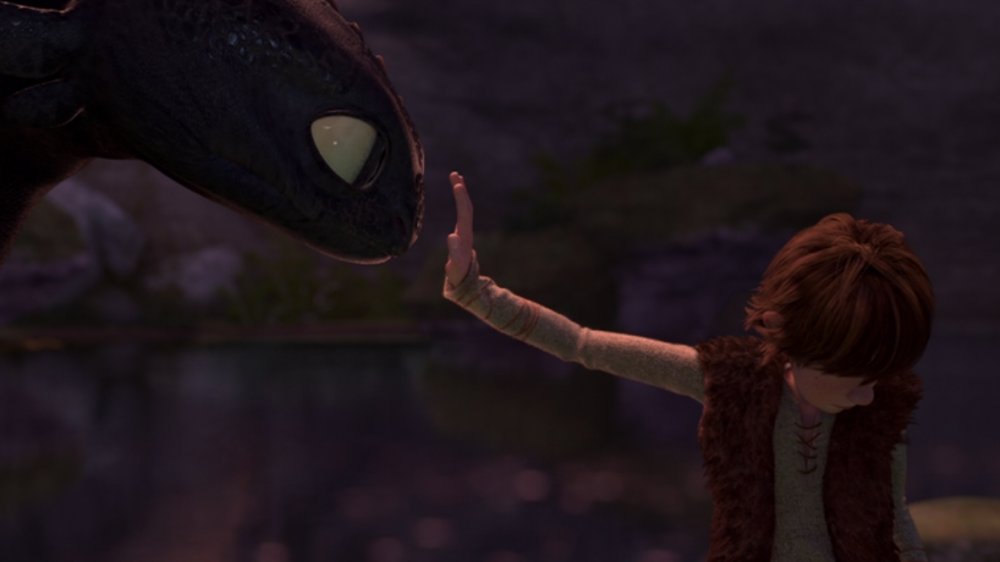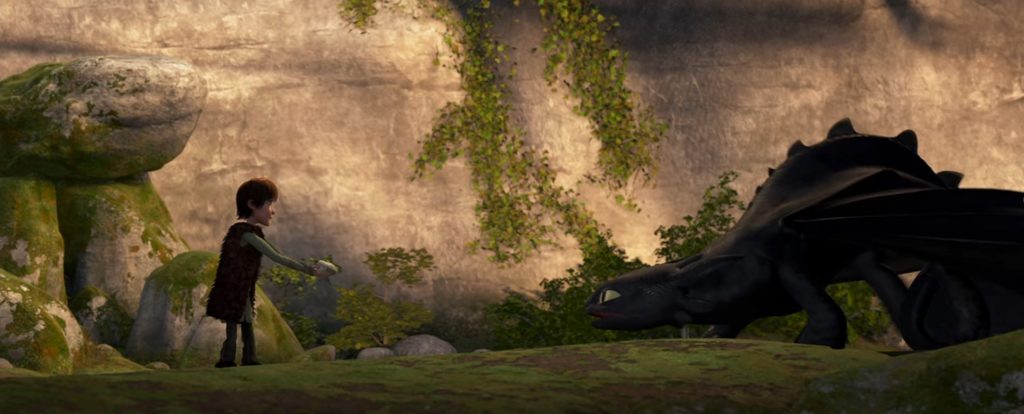Despite the movie’s title, How to Train Your Dragon does not present ‘trained’ dragons. The title insinuates the shift from foe to friend is a means of ‘training’ a dragon, when this is actually achieved through the development of a mutual understanding of the other. The film’s false equation of this mutual agreement reduces the human-dragon relationship into a familiar, domesticated one. While this is identifiable to its young audience, it overlooks the nuances within Toothless and Hiccup’s relationship.
In the film, the human-dragon relationship is mutually agreed upon, and as such presents a level of equality within it. This is established through Toothless and Hiccup’s first interaction, in which both parties choose separately not to kill the other. This choice is depicted as possessing equal value using gaze. Within the scene, both characters stare at the other before choosing pacifism. The gaze becomes a means of seeing universal fear in the other party’s eyes, and the reversal between potential killer and victim allows for this fear to be mutual. The camera angle in these moments is a close up, which focuses on the victim rather than the aggressor. For example, Toothless closes his eyes and lets out a low moan, both signs that he resigns himself to death. This is accompanied with the orchestral music reaching a crescendo, thereby emphasising the suspense of the moment. They share the same reaction: both characters are surprised when released; both shut their eyes at their presumed mortality. As such, their identical reactions create a parallel between the characters and the audience’s response. This focus on shared gaze is repeated when Hiccup extends his arm out to Toothless as a sign of friendship. Notably, Hiccup actively averts Toothless’ gaze, and as such presents touch as a new means of presenting trust. As a result, averting his gaze shifts from being a moment of concession to one of trust, and thereby gives Toothless the choice to accept him.

Whilst Toothless is given this choice, his agency is limited within the relationship through his inability to fly away. As a result, the initial scenic shot of the discovered forest not only presents a visually separate location from the domesticity of Berk, but also a source of entrapment for Toothless. The high angle when Toothless initially notices Hiccup’s presence establishes the difference in power, as Hiccup is placed not only higher than Toothless, but this height also presents freedom to leave. Subsequently, Toothless becomes reliant on Hiccup for both food and flight. This is significant as it presents a dependency on the human, and consequently skews the dynamic of the relationship. The director highlights this when Toothless is presented with the false idea of renewed flight, as he actively attempts to leave Hiccup and pursue independence. This choice is notable as it shows Toothless’ preference for independence and emphasises how he can never be truly autonomous due to Hiccup’s trap damaging his fin. The use of the human to not only create, but also solve, problems exhibits an underlying issue with human interference. However, the film focuses on this dependency as a means of flight, and as a result shifts the focus away from human control, and instead draws attention to the synergy in achieving flight collectively.

In conclusion, How to Train your Dragon presents a romanticised form of control through placing it within a perceived equal value. This is due to the film’s family audience restricting its ability to fully enunciate the issues of domesticating dragons. It is not that the dragon learns, but rather becomes unable to live autonomously through human intervention.